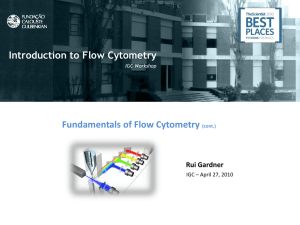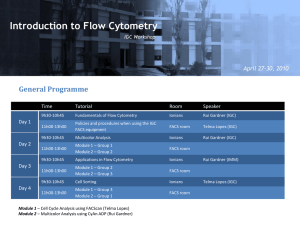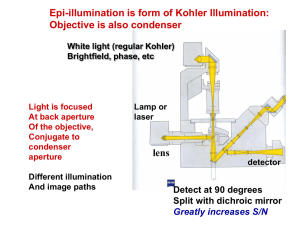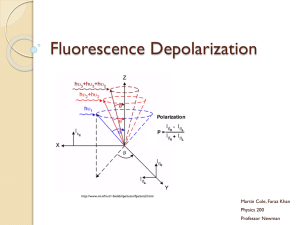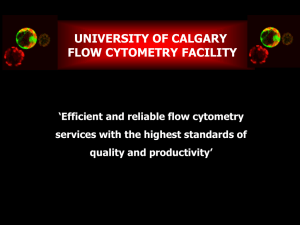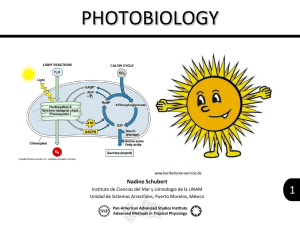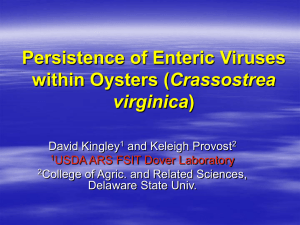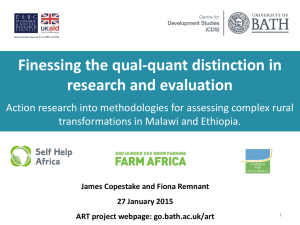Applications - Espace d`authentification univ
advertisement
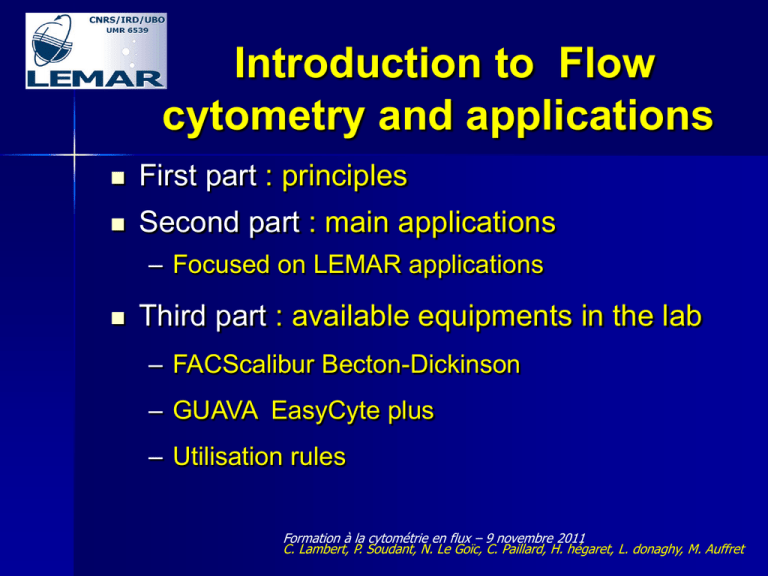
Introduction to Flow cytometry and applications First part : principles Second part : main applications – Focused on LEMAR applications Third part : available equipments in the lab – FACScalibur Becton-Dickinson – GUAVA EasyCyte plus – Utilisation rules Formation à la cytométrie en flux – 9 novembre 2011 C. Lambert, P. Soudant, N. Le Goïc, C. Paillard, H. hégaret, L. donaghy, M. Auffret What is flow cytometry? Measurement of cell characteristics in a stream of fluid A laser beam is focused on the moving cells Scattered light and emitted fluorescence are detected and converted in an electronic pulse Basic Scheme Classical flow cytometer is combining three systems 1- Fluidics – introduction of the cells in the analyze chamber 2 - Optics – Production and collection of scattered light and emitted fluorescence 3 - Electronics – Conversion to digital values and storage on a computer for data analysis TM 1-Fluidics-FACSCalibur Need to have cells in suspension flow in single file through an illuminated volume Fluidics: hydrodynamic focusing 80 µm Capillary Guava : 100 µm needle Facs : 12 µL/min 60 µL/min Accomplished by injecting sample into a sheath fluid as it passes through a small (50-300µm) orifice (laminar coaxial flow - Bernoulli Effect) Fluidics: hydrodynamic focusing Sheath fluid Laminar Coaxial Flow The Bernoulli Effect Direction of flow Lower pressure Velocity Gradient Viscous drag along walls. Particles move to low pressure area hoy@cf.ac.uk New technologies : without fluid Capillary Fluidics: Sample requirements for flow cytometry A suspension of single cells or other particles in a suitable buffer, usually PBS (phosphate buffer saline) Typical density : 105 - 107 cells / ml (FACS) 104 - 5.105 (Guava) Acquisition speeds : up to 1000 events / sec typical 300/800 (FACS) (max 500 : Guava) Particles size (range) : from ~1 µm to ~40/50 µm hoy@cf.ac.uk Fluidics : Sample preparation for flow cytometry • Suspensions: straightforward samples • Non-adherent cell cultures • Circulating cells (blood cells, haemocytes in haemolymph... • Water borne micro-organisms (zooplankton, phytoplankton… • Suspensions of bacteria, yeasts, viruses. hoy@cf.ac.uk Fluidics : Sample preparation for flow cytometry • Sources requiring more preparation • . Adherent cultures and solid tissues have to be processed to release cells as a suspension • • • Enzymatic digestion : trypsin, collagenase, pronase. Chelating agents - removal of ‘binding’ ions : EDTA, EGTA. Mechanical : teasing, sieving, aspiration (syringing) and sonication. • Chromosomes can be released from mitotic cells • Nuclei can also be recovered from tissues stored in paraffin blocks hoy@cf.ac.uk 2- Optics Light source (excitation) is constituted of – Laser beam (blue laser 488nm) – lens and prisms allow to focus the laser beam Optical reception is constituted of – a mirror system and optical filters which direct specific wavelengths to the corresponding detector 2- Optics : Basic Optics of a Flow Laser(s) Cytometer Dichroic mirrors 1 2 3 Cell Collection Lenses Scatter Low & High angle Band Pass Filters Photomultiplier tubes hoy@cf.ac.uk 2- Optics: What kind of information are provided by a flow cytometer? Relative size (Forward Scatter- FSC) : diffracted light on the small angle Nbr of events Laser Facs academy FSC FACS Academy Invitrogen 2- Optics: What kind of information are provided by a flow cytometer? Internal or complexity relative ‘ granularity ’ (Side Scatter-SSC) : diffracted light on the right angle SSC Laser Invitrogen Nbr of events 2- Optics: What kind of information are provided by a flow cytometer? Relative intensity of fluorescence – FL1 – FL2 – FL3 (530 / 30 nm, BP – 525/30 nm BP ) (585 / 42 nm, BP – 583/ 26 nm BP) (> 670nm, LP – 680/30 nm BP ) Site BD/ Fluorescence Spectrum Viewer FACS Academy 2- Optics: What kind of information are provided by a flow cytometer? Possibility to use several fluorochromes with different emission wavelengths. Great diversity of fluorescent probes are now available Relative intensity of fluorescence (FL1, FL2, FL3) Fluorescence is the property of a molecule to absorb light of a particular wavelength and re-emit light of a longer wavelength. Relative intensity of fluorescence (FL1, FL2, FL3) The intensity of the fluorescence is proportional to the number of antibody fixation sites. • Applications: • Cell cycle and ploïdy analysis using DNA staining • Cell viability, cell functions • Enzymatic activities • Quantification of pigments • etc.. 3- Electronics Creation of a pulse : conversion of the optical signals into proportional electronic signal (pulse) 3- Electronics Analyze height, width, and area of the pulse Computer interface for data processing Listed and displayed as Flow Cytometry Standard (FCS) Files Interpreting Multi-parameter Data Single parameters (univariate) can be displayed as a histogram. Dual parameter (bivariate) data can be displayed in two dimensions using dot or density plots. Three parameters may be displayed as a 3-D projection, these are not always easy to interpret and can often be ambiguous. Introduction to Flow cytometry (Invitrogen ~12 min video) http://probes.invitrogen.com/resources/education/t utorials/4Intro_Flow/player.html Complementary notions Fluorescence compensation Fret Fluorescence compensation Compensation is the process by which the fluorescence “spillover” originating from a fluorochrome other than the one specified for a particular PMT detector is subtracted as a percentage of the signal from other PMT’s. FITC PE FRET Fluorescence Resonance Energy Transfer If two fluorescent molecules with suitable spectral overlap are in close proximity, then the energy from the excited state of one molecule (the DONOR) can be transferred to the second molecule (the ACCEPTOR), absorbed and then re-emitted. FRET Fluorescence Resonance Energy Transfer Typical donor/acceptor pairs: – – – – – Fluorescein / rhodamine Fluorescein / eosine Fluorescein / pyrenebutyrate Anthranilamide / nitrotyrosine Coumarin / ethidium bromide Utilisation: • detect if two labelled protein or nucleic acids come into contact or a doubly labelled single molecules is hydrolysed • detect changed in conformation • measure concentration by a competitive binding assay Advantages of FCM High speed analysis Multi-parameter data acquisition Cell sorting Introduction to Flow cytometry (Invitrogen ~12 min video) http://probes.invitrogen.com/resources/education/t utorials/4Intro_Flow/player.html Part II : Applications of Flow Cytometry Cellular parameters measurable by flow cytometry. Without probes : size, shape, cytoplasmic granularity, autofluorescence and pigmentation. With probes : DNA content, DNA composition, DNA synthesis, chromatin structure, RNA, protein, sulphydryl groups, antigens (surface, cytoplasmic & nuclear), lectin binding sites, cytoskeletal components, membrane structure (potential, permeability & fluidity), enzyme activity, endocytosis, surface charge,receptors, bound and free calcium, apoptosis, necrosis, pH, drug kinetics, etc... hoy@cf.ac.uk Most frequent applications in marine biology and oceanography Discrimination and identification of different cell types in various matrix Assessment of cell viability, cell cycle, physiological status, cell biochemical composition Cell sorting coupled to cell culture or other assays (PCR) Applications in marine biology and oceanography • • • • • • • • • Cell counting (hemocytes, phytoplancton, bacteria, viruses…) Cell morphology (size / complexity) Autofluorescence (pigments: chlorophyll, phycoerythrin… Mortality / viability • Mmembrane Integrity (propidium iodide; SytoxGreen®) • Enzymatic Activities (DCFH-DA) DNA content (Sybr-green®, propidium iodide) Oxidative Activity Apoptosis mitochondrial membrane potential … Bivalve Hemocytes Detection – counting bivalves hemocytes granulocytes Distinction of hemocyte subpopulations based on their size (FSC) and complexity (SSC) Hyalinocytes small agranulocytes Not that simple ! It requires DNA staining with SYBRgreen (fluorescein) of oyster hemocytes R1 = hemocyte aggregated R2 = hemocytes (one cell) R3 = sperm Other = cell debris and unknow stuff Gate : R1*R2*R3 Gate : R2 granulocytes Hyalinocytes Red = aggregates Green = one cell Blue = sperm small agranulocytes Hemocyte mortality rate Prodidium iodide (PI) : PI is incorporated only in cells which had lost their membrane integrity = dead cells with a orange/red-fluorescence Orange/ red Fluorescence (PI) Hemocyte viability Double staining (SYBR-green + propidium iodide) FL1 Dead + live Cellules mortes hemocytes et vivantes FL3 Dead Cellules vivantes Cellules mortes Live hemocytes hemocytes Intracellular Oxidative Activity DCFH-DA (dichlorofluorescein diacetate) (485 nm, 535 nm) DCFH-DA is membrane permeant, within the cells the diacetate group is enzymatically cleaved off (esterase). Both DCFH-DA and DCFH is nonfluorescent. In presence of oxidative activity, they are oxidized to highly fluorescent dichlorofluorescein. Intracellular Oxidative Activity Anion superoxide : O2Peroxyde d’hydrogène : H2O2 Peroxynitrite (NO3-) Oxyde nitrique (NO) Enzymes : – peroxydase – xanthine oxydase – lipoxygenase cytochrome c 1 4 H 0 Intracellular Oxidative Activity a + ) 3 0 ( L R 1 2 increasing IOA S 1 W granulocytes 3 hyalinocytes agranulocytes 1 0 0 1 1 0 F R S 2 0 1 1 R F 1 0 0 1 1 0 1 S 2 0 S 1 C 3 Fluorochrome = DCFH-DA (green fluorescence - FL1) 0 - 1 4 H 0 , Resistant Sensible 160 140 120 100 80 60 40 Au gu st Se pt em be r Ap ri l Ju ly gametogenesis 20 0 Ju ne Activité oxydative intracellulaire (fluorescence verte DCF – FL1) 200 180 M ay Oxidative burst (A.U.) Genetic studies: Effect of genetic stock on oyster immune system and physiological status; Lab experiment IOA of hemocyte from sensitive ’S’ oysters is higher than the one from resistant ‘R’ oysters during gametogenesis. Phagocytosis Principle/ Method: hemocytes – Use of fluorescent latex beads 2 µm: – – Detectable on the FL1 detector of the flow cytometer. Contact between beads and cells (some hours) Estimate the % of active cells (index) Phagocytosis events FL1 Histogram Phagocytosis 2/3 hours After addition of fluorescent beads Gate R1 R1 Gate R1 Phagocytosis Cytochalasin B No cytochalasin Phagocytosis index: % of active cells (more than 3 beads) 30 25 1 bille (- Cyt B) 20 y = 1,5088x - 2,7631 R2 = 0,9484 15 10 5 0 0 5 10 15 3 billes et plus 20 25 Result : interaction between toxin from algae and clam hemocytes. Phagocytose (% hémocytes actifs) 30 Test phagocytose: hémocytes de palourdes / extrait d'Alexandrium % cellules actives incubation 2h00/ 18°C - 16 mars 2007 (moyenne n=11 ou 12 + int conf p = 0.05) les lettres indiquent une différence significative, Anova p < 0,0001 b b 25 20 15 10 a 5 0 contrôle + extrait Alexandrium non toxique Ford, Bricelj, Lambert, Paillard, 2008 (Mar Biol 154, 241-253) + extrait Alexandrium toxique Lysosomes (Lysotracker red) Fluorescent probe: LysoTracker® red • Freely membrane permeant probe that accumulates in intracytoplasmic lysosomal compartments Lysosomes: - intracytoplasmic acidic organelles which contain hydrolases - can fuse with phagocytic vacuoles (phagosomes) - resulting intra-vacuolar acidification and contact of lysosomal enzymes with ingested material favors its degradation. Example: Turbo cornutus hemocytes lysosomal amount High Medium Low Donaghy et al., In preparation Distinction between at least 3 hemocyte populations displaying low, medium and high amounts of intracytoplasmic lysosomes. Differential involvement of hemocyte subtypes in mollusc immune response ? Mitochondrial membrane potential The electron chain transport, responsible of the ATP production, generate a strong electrochemical gradient across the membrane (negative charge inside). This gradient is an indicator of the mitochondrion functionality and of its energetic status. To estimate this gradient : use of JC-10 probe (~JC-1) Mitochondrial membrane potential (MMP) JC-10 probe: two iso-forms - Monomer = green fluo (low MMP) - Agregates = orange fluo (high MMP) (1) Cytoplasm loading Green fluo : monomer Mitochondrial membrane potential (MMP): oyster + cccp : ratio ~1 Ratio green/ orange > 4 Orange fluo : agregates CCCP : Carbonyl cyanide 3-chlorophenylhydrazone : decoupling agent Data from Sébastien Artigaud (Master 2-2010) DNA content and cell cycle DNA content of normal cockle hemocytes DNA content analysis of neoplastic cells Normal Haemocytes Photos: A. Villalba, Spain 4N <2N Neoplastic Haemocytes DNA content analysis of neoplastic cells in haemolymph of the cockle Cerastoderma edule. Examples of heavily diseased cockles 3N 6N 4N 7N 5N 8N Phytoplancton Detection – counting of phytoplancton Based on the fluorescence of pigments (chlorophyll) Karenia mikimotoi 1) Detection FSC Complexity (SSC) Statistics : n = 6 Size (FSC) Karenia debris 1) Detection FL3 FL3 (chlorophyll) Statistics : n = 4 Size (FSC) Karenia debris Nano-pico plancton / cyanobacteria Chlorophyll autofluorescence (red) phycoerythrine autofluorescence (orange) Station 4 Charente estuary Station 3 Station 2 Station 1 Ex 2 : Detection of mixture of 8 eukaryotic cell types + 2 cyanobacteria D’après Marie et al., 2004 Ex 3 : coccolithophore counting, « Size », chlorophyll level. Gephyrocapsa oceanica Ex 3 : coccolithophore counting, « Size », chlorophyll level. SSC 600 FSC Volume (µm3) 500 Linéaire (SSC) y = 6,0728x - 32,317 400 2 R = 0,9337 300 200 100 0 0 10 20 30 40 50 60 70 Echelle relative (FSC ou SSC) SSC value is a better estimation of cocolithophore volume (R²=0,93) than FSC (R²=0,06) Viability / mortality phytoplancton Principle : membrane integrity loss – Chlorophyll : red fluorescence, FL3 detector. – Sytox-green: Yellow-green-fluorescence, 500-530 nm, FL1 detector SYTOX is incorporated only in cells which had lost their membrane integrity = dead cells with a Yellowgreen-fluorescence Viability / mortality Karenia mikimotoi Chlorophyll (FL3) Viability LIVE CELLS DEAD CELLS Karenia mikimotoi Fluorescence SYTOX (FL1) Hansy Haberkorn Micro-algae: lipid content Bodipy stainning (493/503) With copper Tetraselmis sp. 10µm without copper Image: X 100, immersion, epifluorescence HBO, cube I3 (BP450-490/ BS 500 / LP 515) green fluorescence (Bodipy) Autofluorescence of chlorophyll pigments , excited by the laser : red fluo (FL3, 670 LP) lipid droplet stained with Bodipy : green fluo (FL1, 530/30 BP) Bacteria, viruses Bacteria D’après G. Gregory, BD workshop, Marseille, Avril 2009 EB: ethidium bromide, CFA carboxy-fluorescein-diacetate, Rh rhodamine, Pi Propidium oidide, CSE : CHEMUNEX Fluorescent Cell Labeling. Viabilité : Bactérie marine Vibrio aestuarianus (pathogène de C. gigas) Bactéries vivante 31,49% Sélection taille/ complexité Membranes endommagées 3,65% Bactéries "mortes“ 64,86% Double marquage: Sybr® Green I : ADN/ARN (fluo verte/jaune, FL1) Iodure de Propidium: ADN/ARN (fluo orange/rouge, FL2) si perte intégrité membranaire background Viruses D’après G. Gregory, BD workshop, Marseille, Avril 2009 Viruses (Anne-Claire Baudoux) 12 november 2009 Sybr-green staining R1 : viruses (in red) Bacteria Background Some other examples of application in the lab Oyster Sperms Grazing experiment ploidy Sperm viability : using double staining (SYBR-green + propidium iodide) R2 : intact membrane R3 : damaged membrane R4 : loss of membrane integrity Application : interaction GRAZING Dunaliella salina Green micro-algae verte : chlorophyceae Oxyrrhis sp. dinoflagellate GRAZING Grazing: Oxyrrhis / Dunaliella Post doc: Sabine Schultes Oxyrrhis sp. Dunaliella salina Grazing: Oxyrrhis / Dunaliella Post doc: Sabine Schultes suivi concentration en Dunaliella (cell/mL) 120000 concentration (cell/ mL) 103430 99094 107087 108730 100000 80000 84573 Dunaliella + Oxyr. 60000 Dunaliella 40000 45436 20000 1792 652 0 initial 6 heures 24 heures 40 heures Ploidy (oysters) : diploid triploid. On gills cell nucleus : Propidium iodide staining(red fluo FL2) Ploidy (oysters) : ideally Standard beads Ploidy (oysters) Flow cytometry : main manufacturers ‘FACS’ has become a generic term for ALL flow cytometry FACS : Fluorescence Activated Cell Sorter Is actually a trade name of Becton Dickinson (BD). FACS I, II, III, IV, 400, 420, 440, FACStar, Vantage, DiVa, Aria : Sorters. FACS Analyser, FACScan, FACSCalibur*, LSR, FACSCanto: ‘Benchtop’. Coulter (Beckman Coulter) have also produced a significant range of machines. EPICS (Electronic Programmable Individual Cell Sorter), Profile, Elite, XL, ALTRA : a mixture of sorters and ‘benchtops’. Other Manufacturers : GUAVA, Ortho (Cytofluorograph, Cytoron), Skatron, Partec, Dako (Galaxy), Cytomation (MoFlo), DakoCytomation : Cyan benchtop. LEMAR : two systems same optics, various fluidics Facscalibur Becton Dickinson GUAVA Easycyte plus® 96 wells micro-plate reader Fluidic part is reduced Coming soon (dec. 2011) Three lasers 10 detectors Universal loader … Utilisation des cytomètres Personnes « accréditées » = formées Inscription préalable (calendrier) Protocole à respecter – Mise en route – Sauvegarde des données – Nettoyage, fermeture – Bilan d’utilisation mis par écrit Utilisation des cytomètres Compensation financière (coût des appareils : ~80 K€ ) – Entretien hebdomadaire Nettoyage approfondi, calibrage (billes) – révision annuelle Technicien Becton et/ou Guava – Remplacement des pièces usagées – Mise à jour des logiciels

